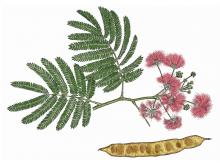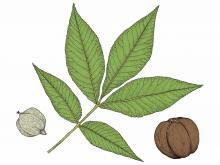Trees, Shrubs and Woody Vines
Media

Species Types
Scientific Name
Koelreuteria paniculata
Description
Golden rain tree is native to China, Korea, and Japan. It was cultivated in Missouri for years. Because it readily escapes from cultivation and is invasive, it is no longer recommended for planting in Missouri.
Media

Species Types
Scientific Name
Gleditsia triacanthos
Description
Though it doesn’t reach a stately size, honey locust commands respect for its many large, strong, usually branched thorns, which can puncture tractor tires as easily as they can poke through tennis shoes! The long, leathery, twisting pods are relished by cattle and by wildlife.
Media

Species Types
Scientific Name
Cercis canadensis
Description
Eastern redbud is a native shrub or small tree that is distinctly ornamental in spring with small, clustered, rose-purple flowers covering the bare branches before the leaves.
Media

Species Types
Scientific Name
Albizia julibrissin
Description
Grown as an ornamental for its attractive pink flower clusters, gracefully spreading branches, and delicate leaves, mimosa is easily propagated and grows rapidly. Unfortunately, it is also an invasive exotic in much of the state.
Media

Species Types
Scientific Name
Juglans nigra
Description
Easily Missouri’s most valuable tree, the black walnut provides the finest wood in the world, as well as delicious nuts. Both are in high demand and thus form an important part of Missouri’s economy.
Media

Species Types
Scientific Name
Rhus glabra
Description
Colonies of smooth sumac are most noticeable in early autumn, because the leaves turn brilliant red! You can make drinks and jellies from the clusters of fuzzy red berries.
Media

Species Types
Scientific Name
Quercus nigra
Description
Its range and interesting, variable leaf shapes identify water oak. Like many species that require wet lowland forests, water oak has been declining in our state due to long-term extensive disruption of natural habitats in our Bootheel counties.
Media

Species Types
Scientific Name
Quercus bicolor
Description
A beautiful tree, swamp white oak features bicolored leaves that are shiny, dark green above and downy white below. When a breeze sets them in motion, their wavy or lobed shapes add a calm grace to a summer's hike.
Media

Species Types
Scientific Name
Quercus marilandica
Description
Blackjack oak is common in dry upland woods, especially ones that have been badly burned. It can grow on the poorest soils. It is rugged but not worth much as lumber. It's one of the first trees to be used as fuel.
Media

Species Types
Scientific Name
Carya ovata
Description
Many Missouri trees are quite useful, and shagbark hickory is a great example. Its wood makes excellent, slow-burning charcoal, its nuts are edible, and its wood is used for many implements. Wildlife from moths to squirrels to bats appreciate shagbarks, too!
See Also
About Trees, Shrubs and Woody Vines in Missouri
There are no sharp dividing lines between trees, shrubs, and woody vines, or even between woody and nonwoody plants. “Wood” is a type of tissue made of cellulose and lignin that many plants develop as they mature — whether they are “woody” or not. Trees are woody plants over 13 feet tall with a single trunk. Shrubs are less than 13 feet tall, with multiple stems. Vines require support or else sprawl over the ground.





















